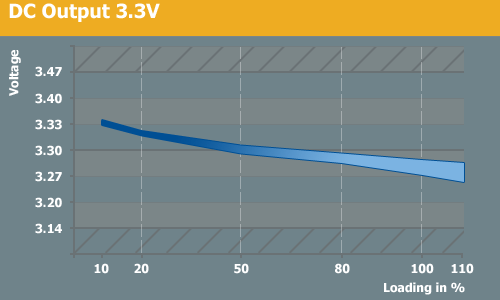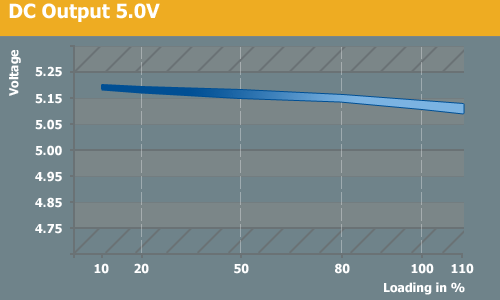FSP Epsilon 80Plus 600W
by Christoph Katzer on August 5, 2008 8:00 PM EST- Posted in
- Cases/Cooling/PSUs
DC Output Stability and Quality




The voltage stability is close to amazing with this unit - unfortunately something we don't always see. The 3.3V rail had the largest regulation with a little more than 2% from the important rails. The 5V rails stayed above 5.00V throughout our load testing. All four 12V rails stayed well within specs, with only 0.6% regulation - perhaps the best we have seen so far. All of the different voltages delivered low ripple and noise results, staying well within specs.










19 Comments
View All Comments
Amart - Wednesday, August 6, 2008 - link
-1FSP Epsilon above 500W are known to have Ripple/Noise problems, and the "spec" for maximum is much higher then anyone would want to buy.
Capacitors age, and Ripple/Noise increases over the lifetime of this product - so starting out very-low is a requirement for a quality unit. I've seen plenty of tests of $80+ units that failed to provide the quality they promised.
C'DaleRider - Wednesday, August 6, 2008 - link
Fucktard? My, my, little boy games calling names....makes you such a big boy, doesn't it?I guess despite the education proper testing sites have attempted to do in testing power supplies has eluded you. Ripple and noise is quite important...but since you care not for ever seeing the values presented, and it's not hard to get them, AT's vaunted Chroma gives them so why cannot they be presented is beyond me.
And to show the ripple/noise graphing is very simple, too. An oscilloscope is all that's needed....and if a website can afford a Chroma, it certainly can afford an oscilloscope.
Without proper presentation of ripple/noise generation at given output levels, their testing is incomplete. To be within spec is rather meaningless as 115mV of ripple on the +12V rail at full rated output is within spec, but I wouldn't buy a power supply that produced that much ripple/noise.
Come on AT, get with the program and show us complete information, or is HardOCP, Hardware Secrets, and JonnyGuru's sites the only ones that will do proper testing and leave you as an also-ran testing site.
strikeback03 - Wednesday, August 6, 2008 - link
If you don't trust them to say "Ripple Results are fine" then why would you trust a graphic? Never heard of Photoshop? Or use Labview to generate a signal to be read by an oscilloscope? If a reviewer actually wants to deceive, a picture isn't any harder.JarredWalton - Wednesday, August 6, 2008 - link
That's pretty much my thoughts as well. Christoph did include ripple tests and charts in some previous articles (http://www.anandtech.com/casecoolingpsus/showdoc.a...">for example, this roundup), but didn't feel like the amount of time required to generate all the charts really added anything to the results. Given that he HAS done those tests in the past, I see no reason to think that he's not conducting those tests now. That he condenses a bunch of charts that take a significant amount of effort to create into a short statement on ripple doesn't really bother me at all. Though I do have to say, at least reporting the mV ripple values as he's done in the past would be good.Amart - Thursday, August 7, 2008 - link
He does NOT condense. If he wanted to condense he would give the average number he's getting from the calculation.Simply saying that something is "within spec" is unacceptable in a professional review, for reasons outlined in the above replies.
He must show the numbers, whether in a graph or simply writing them down. It won't take more space or time - if he's actually doing the testing.
JarredWalton - Thursday, August 7, 2008 - link
Usually Christoph has listed the ripple values. I'm not sure why he didn't put them in this article. Compare to the last article, where he mentions 8mV or whatever. I'll flog him and make sure we get some numbers for future PSUs. :)Amart - Friday, August 8, 2008 - link
Why not for this one? This isn't paper print, you can edit.Both methodology and results for such key testing should be posted or linked within the article - just like on other sites.
HOOfan 1 - Thursday, August 7, 2008 - link
I personally would rather see specific values for ripple rather than oscilloscope shots. By the same measure, I would rather see specific values for voltage regulation, rather than line graph. I would rather see specific AC input versus DC output numbers instead of a line graph for efficiency. All of these should be simple and quick to whip up into a chart. As for the FSP Epsilon, for most in North America where the superior Corsair CWT and Seasonic designs can be had for the same price or even less money, I say going with the superior designs of CWT and Seasonic is a no brainer. Same for the new BFG LS line that has popped up...they need to drop the price by about $15-$20 before they can even hope to compete with the value that Corsair is putting out there.larson0699 - Wednesday, August 6, 2008 - link
I'll take their word for it....especially having already concluded that this is a good unit but still nothing on Seasonic's S12II/M12II line. Their testing is sufficient to validate that.
You can say what you want about AT, but it's their game and I think they're damn good at it, and ooh look at the pretty colors *drool*. You may find yourself more comfortable reading , Hot, Tom's, I don't care, but that's _your_ preference and one I can respect, at least moreso than "boo fuckity hoo your testing is incomplete OMGWTFBBQ". I'll tell you what'll really get results: Buy the unit, suppress the mouth.
I said good day.